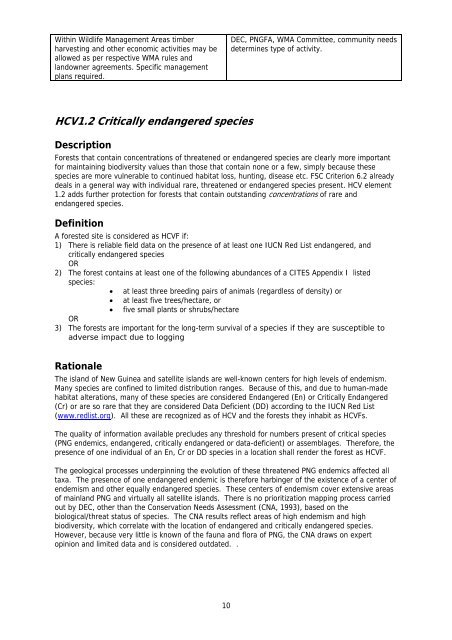A National Interpretation of the High Conservation Value Forest ...
A National Interpretation of the High Conservation Value Forest ...
A National Interpretation of the High Conservation Value Forest ...
Create successful ePaper yourself
Turn your PDF publications into a flip-book with our unique Google optimized e-Paper software.
Within Wildlife Management Areas timber<br />
harvesting and o<strong>the</strong>r economic activities may be<br />
allowed as per respective WMA rules and<br />
landowner agreements. Specific management<br />
plans required.<br />
DEC, PNGFA, WMA Committee, community needs<br />
determines type <strong>of</strong> activity.<br />
HCV1.2 Critically endangered species<br />
Description<br />
<strong>Forest</strong>s that contain concentrations <strong>of</strong> threatened or endangered species are clearly more important<br />
for maintaining biodiversity values than those that contain none or a few, simply because <strong>the</strong>se<br />
species are more vulnerable to continued habitat loss, hunting, disease etc. FSC Criterion 6.2 already<br />
deals in a general way with individual rare, threatened or endangered species present. HCV element<br />
1.2 adds fur<strong>the</strong>r protection for forests that contain outstanding concentrations <strong>of</strong> rare and<br />
endangered species.<br />
Definition<br />
A forested site is considered as HCVF if:<br />
1) There is reliable field data on <strong>the</strong> presence <strong>of</strong> at least one IUCN Red List endangered, and<br />
critically endangered species<br />
OR<br />
2) The forest contains at least one <strong>of</strong> <strong>the</strong> following abundances <strong>of</strong> a CITES Appendix I listed<br />
species:<br />
• at least three breeding pairs <strong>of</strong> animals (regardless <strong>of</strong> density) or<br />
• at least five trees/hectare, or<br />
• five small plants or shrubs/hectare<br />
OR<br />
3) The forests are important for <strong>the</strong> long-term survival <strong>of</strong> a species if <strong>the</strong>y are susceptible to<br />
adverse impact due to logging<br />
Rationale<br />
The island <strong>of</strong> New Guinea and satellite islands are well-known centers for high levels <strong>of</strong> endemism.<br />
Many species are confined to limited distribution ranges. Because <strong>of</strong> this, and due to human-made<br />
habitat alterations, many <strong>of</strong> <strong>the</strong>se species are considered Endangered (En) or Critically Endangered<br />
(Cr) or are so rare that <strong>the</strong>y are considered Data Deficient (DD) according to <strong>the</strong> IUCN Red List<br />
(www.redlist.org). All <strong>the</strong>se are recognized as <strong>of</strong> HCV and <strong>the</strong> forests <strong>the</strong>y inhabit as HCVFs.<br />
The quality <strong>of</strong> information available precludes any threshold for numbers present <strong>of</strong> critical species<br />
(PNG endemics, endangered, critically endangered or data-deficient) or assemblages. Therefore, <strong>the</strong><br />
presence <strong>of</strong> one individual <strong>of</strong> an En, Cr or DD species in a location shall render <strong>the</strong> forest as HCVF.<br />
The geological processes underpinning <strong>the</strong> evolution <strong>of</strong> <strong>the</strong>se threatened PNG endemics affected all<br />
taxa. The presence <strong>of</strong> one endangered endemic is <strong>the</strong>refore harbinger <strong>of</strong> <strong>the</strong> existence <strong>of</strong> a center <strong>of</strong><br />
endemism and o<strong>the</strong>r equally endangered species. These centers <strong>of</strong> endemism cover extensive areas<br />
<strong>of</strong> mainland PNG and virtually all satellite islands. There is no prioritization mapping process carried<br />
out by DEC, o<strong>the</strong>r than <strong>the</strong> <strong>Conservation</strong> Needs Assessment (CNA, 1993), based on <strong>the</strong><br />
biological/threat status <strong>of</strong> species. The CNA results reflect areas <strong>of</strong> high endemism and high<br />
biodiversity, which correlate with <strong>the</strong> location <strong>of</strong> endangered and critically endangered species.<br />
However, because very little is known <strong>of</strong> <strong>the</strong> fauna and flora <strong>of</strong> PNG, <strong>the</strong> CNA draws on expert<br />
opinion and limited data and is considered outdated. .<br />
10

















